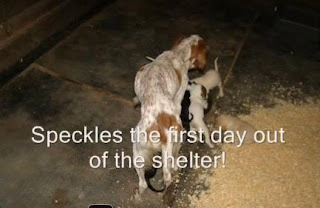Merry Christmas From Us To You. The above picture is Buddy. He is a rescue from TN. He was found by Animal Control tied to a tree. His family moved and left him behind. He had so many trust issues. I managed to win him over, and he is a forever critter of our rescue kennel.
______________________________________________
It is very important for anyone that does animal rescue to document the health and behavior of each of the rescue animals in their care. It is just as important to have a detailed written time line as it to have a in-depth photographic time line. This serves as a more detailed guide for the care giver. It also serves as evidence if you ever need it for what ever reason.
There are a couple of ways to keep written documentation. You can use a free open source service called Animal Shelter Manager. It is a data base program that stores the info on all your animals in one spot. There are other similar programs that you can buy that would make record keeping less tedious.
Even if you use a computer or data base program for record keeping it pays to back everything up with hard copies of your records. You never know when the technology we depend on can fail. A disastrous crash of a much relied on computer can be enough to send any rescuer in to a feverish panic. You can simply use plain manila folders and file your documents in regular filing cabinet. Inside the folder you can use a simple form that allows you to document, vaccinations, de-worming, vet visits and behavioral notes for that animal. You should include in the folder all hard copies of any vet visits that the animal may have had. You can customize and tweak your manual filing system to fit your needs.
It would be a good investment to back your information up a 3rd way. A rescuer should give considerable thought to also backing up all records with a removable flash drive or saving their info to a CD or floppy disks.
Things that need documented via a computer program, hard copies and removable storage and are the following…
A: Basic Info:
1- Animal’s Name
2- Birth Date or Estimated Birth Date
4- Breed, or Estimated Breed
5- Sex
6- Color & Markings
7-Length Of Coat
8- When the animal arrived at your place and how you obtained it!
It is a good idea to include a current up to date picture of the animal to place in it’s file.
B: Behavior/Training
You should note things that indicate if the animal is over all good-natured, has fear aggression, likes people, gets along with other animals of other species. If you are dealing with dogs, note if the dog is good on a leash and if he/she is well-behaved if restrained. Note if the animal has any known destructive behaviors. You should also mention if it is small companion animals you are documenting if they are house trained etc.
C: Health Notes
1-Date Of Vaccinations
2-Dewormings Should Be Documented
3-Any special Test, and when last done( ex: Heartworm Test For Dogs)
4-Note Any Medical Treatments given at home or ordered by the vet.
5-Date Of Spay/Neuter for small companion animals.
6-If the animal dies or you had to have it euthanized that needs to be recorded on the animal’s file.
D: Miscellaneous Notes
Here you can document anything that you have not covered other wise. For example you can make a note in this area if the pet requires a specialized diet.
As with any record, it is important to put the date on it when any new information is entered. It is very important to keep everything current and dated. This applies even if you are just jotting down a note that takes a mere 2 seconds to write.
Having detailed written documentation coupled with in-depth photographic records can greatly benefit the rescuer. A rescuer can review the evidence at hand and determine if their current program is working or not. Having all your plentiful detailed information will also provide you something to fall back on if you ever need to reveal it as proof. You may have to use it to present a case against someone. When trying to prove neglect or abuse it’s good to have all your ducks in a row. There is also a chance you can use it as proof to support many arguments if you are defending your actions in a court of law. You can never have enough documentation if you deal with rescue animals. As stated in the previous article it pays to keep in mind that what is NORMAL to the people who deal with rescue animals may not appear that way to outsiders. It is human nature to want to demonize others and assume the worst.







